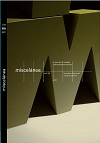Turismo y conflictos identitarios en Alentejo Blue, de Monica Ali
DOI:
https://doi.org/10.26754/ojs_misc/mj.20176788Palabras clave:
Monica Ali, Alentejo Blue, ciclo de relatos, turismo, escrituraResumen
El presente artículo explora la problemática del encuentro cultural en la obra de Monica Ali Alentejo Blue (2006), cuya acción se sitúa en Mamarrosa, un lugar ficcional en la región portuguesa del Alentejo. Esta colección la componen nueve relatos focalizados de manera alternativa por diferentes personajes, lo que señala a la posición liminal de la obra, a medio camino entre los géneros de la novela polifónica y el ciclo de relatos. Alentejo Blue se resiste a una definición categórica en términos de género literario, lo cual refleja la naturaleza heterogénea de las perspectivas
de los personajes, que comprende desde expatriados británicos y turistas hasta la visión que de estos tienen los habitantes del lugar. La disparidad de estas visiones en esta encrucijada cultural no favorece encuentros inspiradores entre los personajes, sino que alimenta la frustración y un sentimiento de dislocación profunda, desvelando la incapacidad de resolver conflictos. El artículo también analiza el segundo relato de la colección, que muestra la experiencia del escritor británico Harry Stanton en el Alentejo, paradigmática en sí misma de una proyección subjetiva de las preconcepciones y prejuicios que a menudo intervienen en la construcción de lugar de los turistas, en estrecha relación con las barreras erigidas culturalmente
entre el yo y el Otro.
Descargas
Citas
Ali, Monica. 2003. “Where I’m Coming From”. The Guardian (June 17). <http://www.theguardian.com/books/20 03/jun/17/artsfeatures.fiction>. Accessed October 7, 2016.
Ali, Monica. 2006. Alentejo Blue. London: Doubleday.
Bauman, Zygmunt. 1994. “From Pilgrim to Tourist”. Moderna Tider (September): 18-36.
Bauman, Zygmunt. 2001. “Ambivalence and Order”. In Beilharz, Peter (ed.) The Bauman Reader. Oxford: Blackwells: 288-297.
Berger, John. 1972. Ways of Seeing. Harmondsworth: Penguin.
Boehmer, Elleke. 2005. Stories of Women: Gender and Narrative in the Postcolonial Nation. Manchester: Manchester U.P.
Craik, Jennifer. 2005. “The Culture of Tourism”. In Rojek, Chris and John Urry (eds.) Touring Cultures: Transformations of Travel and Theory. London: Routledge: 113-136.
Dunn, Maggie and Ann Morris. 1995. The Composite Novel: The Short Story Cycle in Transition. New York: Twayne.
Ferguson, Susan. 2003. “Sequences, Anti-Sequences, Cycles, and Composite Novels: The Short Story in Genre Criticism”. Journal of the Short Story in English (41): 103–117.
Garland Mann, Susan. 1988. The Short Story Cycle: A Genre Companion and Reference Guide. Westport: Greenwood Press.
Germanà, Monica. 2011. “From Hijab to Sweatshops: Segregated Bodies and Contested Space in Monica Ali’s Brick Lane”. In Teverson, Andrew, Sara Upstone and Edward Soja (eds.) Postcolonial Spaces: The Politics of Place in Contemporary Culture. Basingstoke: Macmillan: 67-82.
Gregg, Allan. 2011. “Monica Ali on Brick Lane and Alentejo Blue”. <https://www.youtube.com/watch?v=eXotqauHbC8>. Accessed October 7, 2016.
Ingram, Forrest. 1971. Representative Short Story Cycles of the Twentieth Century. Studies in a Literary Genre. The Hague: Mouton.
Kennedy, Gerald (ed.) 1995. Modern American Short Story Sequences: Composite Fictions and Fictive Communities. Cambridge & New York: Cambridge U.P.
Kral, Francoise. 2005. “Fictional Contexts, Actual Contexts, and Virtual Contexts in Brick Lane by Monica Ali”. Commonwealth Essays and Studies 28 (1): 109-118.
Luscher, Robert. 1989. “The Short Story Sequence: An Open Book”. In Lohafer, Susan and Jo Ellyn Clarey (eds.) Short Story Theory at a Crossroads. Baton Rouge: LSUP: 148-167.
March-Russell, Paul. 2009. The Short Story An Introduction. Edinburgh: Edinburgh U.P.
Marino, Elisabetta. 2008. “From Brick Lane to Alentejo Blue: Cross-cultural Encounters in Monica Ali’s Writing”. British and American
Studies (14): 51-58.
Mudge, Alden. 2006. “Monica Ali: Second Act”. BookPage (July). <http://bookpage.com/interviews/8360-monica-ali#.VgkeDMvtlBc>. Accessed 7 October, 2016.
Pérez Fernández, Irene. 2009. “Representing Third Spaces, Fluid Identities and Contested Spaces in Contemporary British Literature”. Atlantis: Journal of the Spanish Association of Anglo-American Studies 31 (2): 143-160.
Rojek, Chis. 2005. “Indexing, Dragging and the Social Construction of Tourist Sights”. In Rojek, Chris and John Urry (eds.) Touring Cultures: Transformations of Travel and Theory. London: Routledge: 52-74.
Shriver, Lionel. 2006. “On the Way to Nowhere”. The Daily Telegraph (June 11). <http://www.telegraph.co.uk/culture/books/3652842/On-the-way-to-nowhere.html>. Accessed 7 October, 2016.
Suárez Lafuente, Socorro. 2007. “La historia especial de la novela inglesa contemporánea: De Pilgrims a Nómades”. Odisea (8): 187-197.
Taylor, Catherine 2006. “Alentejo Blue by Monica Ali”. Independent (June 3). <http://www.independent.co.uk/arts-entertainment/books/reviews/alentejo-blue-by-monicaali-8596048.html>. Accessed 7 October, 2016.
Urry, John. 2002. The Tourist Gaze. London: Sage.
Urry, John and Chris Rojek (eds.) 2005. Touring Cultures: Transformations of Travel and Theory. London: Routledge.
Walter, Nathasha 2006. “Alentejo Blue by Monica Ali”. The Guardian (May 20). <https://www.theguardian.com/books/2006/may/20/featuresreviews.guardianreview14>. Accessed 7 October, 2016.
Weiss, Allan. 2009. “Between Collection and Cycle: The Mini-Cycle”. Short Story 17 (2): 78-90.
Zavala, Lauro. 2012. “The Boundaries of Serial Narrative”. In Patea, Viorica (ed.) Short Story Theories: A Twenty-first Century Perspective. Amsterdam: Rodopi: 281-297.
Descargas
Publicado
Cómo citar
Número
Sección
Licencia

Esta obra está bajo una licencia internacional Creative Commons Atribución-NoComercial 4.0.


